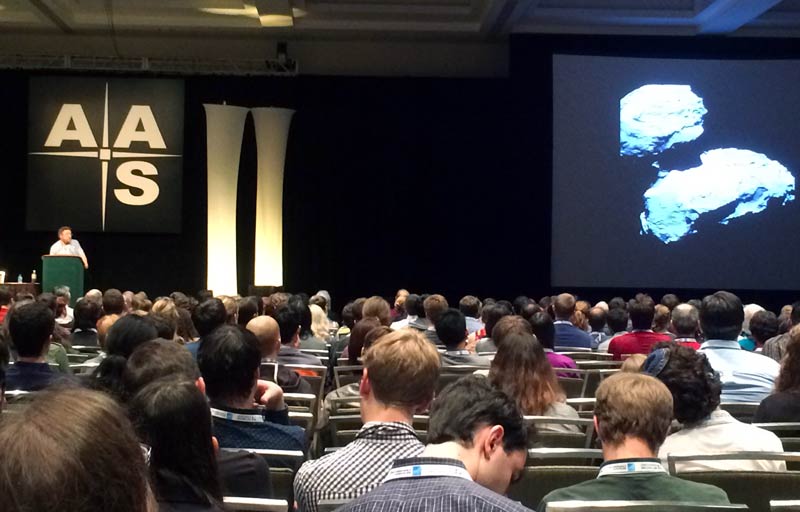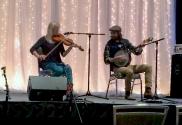American Astronomical Society Meeting
January 4, 2015 to January 8, 2015
Seattle, Washington
Meeting host: By:Sara Frederick
SPS Chapter:

The Astronomy community is defined by its familial closeness and unique personalities, traits which did not fail to surface during my second time attending the American Astronomical Society (AAS) Winter Meeting. From the open-mic night displaying members’ humorous spoken-word talents, to plenary talks eliciting a rumble of laughs from an audience of hundreds; it became clear to me that the Astronomy community also has a healthy sense of humor. The meeting also had its serious moments, but let us pause a moment for introductions:
I am a senior physics and astronomy major from the University of Rochester, and I attended the 2015 AAS Meeting to present a poster with the results of my work from a Summer Undergraduate Research Fellowship (SURF) with the Laser Interferometer Gravitational-wave Observatory (LIGO) scientific collaboration (LSC) based at Caltech. My project involved researching the effect of precessing orbits on the gravitational waveforms from coalescing binary black holes, and how this effect is likely to influence detections. I knew full well that my experience presenting this year would be much different than last year, as I had just recently delivered a barrage of graduate school applications. I expected that my poster would most certainly attract representatives from those schools there to informally interview their latest candidates. My final day in Seattle would consist of standing at attention in front of my research achievements, readied with questions and answers of my own for the scouts hidden in the crowd.
In between researching graduate programs and the people I would be likely to encounter at the poster session, I attended many talks, including the Gravitational Waves Session. This session celebrated 100 years since Einstein’s formulation of general relativity and included an overview of the history of the field given by MIT’s Rainer Weiss. The same day, I attended a plenary talk detailing the landing of the Rosetta mission on comet 67P/Churyumov-Gerasimenko, during which Paul Weissman elicited laughs from the audience by comparing the shape of the comet to a “rubber ducky”. Later in the week, more laughs were had during a plenary talk by Max Tegmark about inflation and parallel universes. He began the talk with the advice to never mention interest in multiverses “if you want any chance of being admitted [into a graduate program]” and described the cosmic microwave background with the help of an inflatable toy globe (very much appropriate for a talk on inflation).
Aside from the usual sessions and talks, there were plenty of events for undergraduates at the meeting, including a series of special talks “For Undergraduates & Other Inquiring Minds.” The Undergraduate Orientation offered a chance for students to meet representatives from various schools and programs, including SPS. An SPS Evening of Undergraduate Science allowed us to display our posters in a student-only setting and hear encouraging words from NASA Astrophysics Division Science Mission Director Paul Hertz on pursuing a career in astronomy. For the second year in a row I also attended a series of “Career Hours” by Alaina G. Levine, founder of Quantum Success Solutions, during which I learned much about interview etiquette and careers available beyond academia for astronomers.
On off-hours, many fun events took place, including Open-Mic Night. The audience was kept in a constant state of giggles from Guy Worthy’s self-written “Alaska Cats” (performed with help from members of the audience playing various percussion instruments), to Doug Shield’s poem “Galaxy People,” complete with colloquium-style slides, to “Celestia L’Passion’s” steamy spoken word piece about a night of observing meant to be a proposal for telescope time. Kaylyn Henderson also received laughs when he began his beautiful piano piece by dedicating it to the members of the Hubble committee in the audience.
My favorite part of the meeting took me somewhat by surprise. As I perused the schedule booklet upon my arrival, a workshop caught my eye that I had not noticed during registration. It was on the topic of something called “Imposter Syndrome” – the state of mind affecting academics who think of themselves as not good enough to succeed legitimately in their field, but as “imposters” who somehow don’t deserve it. As a psychology minor, I had some interest in seeing what this workshop was about, so I signed up immediately. I was surprised when I arrived at the workshop to see that it was not just women and minorities in the audience (the demographics claiming the majority of “imposters”), but astronomers of all ages and distinctions. The organizer, Johanna Teske, began by talking about her own struggles with the imposter syndrome during graduate school and how she was able to overcome them. She also introduced many successful celebrities who struggled with thoughts of comparative inferiority, including Maya Angelou, Jodie Foster, Don Cheadle, and Sonya Sotomayor. Each workshop participant was encouraged to work their way through a series of questions with a neighbor, and the attendees came together after each point to share. In this way, members in the room little-by-little revealed their insecurities despite their accomplishments (most notably an audience member who was both a Hubble and a TED Fellow). I left the workshop feeling closer not only to the young woman who was my partner, but to the other 60 or so astronomers in the room.
The first time I attended the AAS, I felt incredibly overwhelmed and somewhat daunted by the huge collection of brilliant minds all in one setting. This meeting taught me, however, that even brilliant minds are given to playful quips during their scientific talks. It also taught me that, behind some scientists’ intimidatingly successful demeanors, there are many who feel like imposters, and this epidemic of inferiority complexes must be addressed. I left determined to carry this information back to my peers, and look forward to further building the community with this motley crew of astrophysicists.


